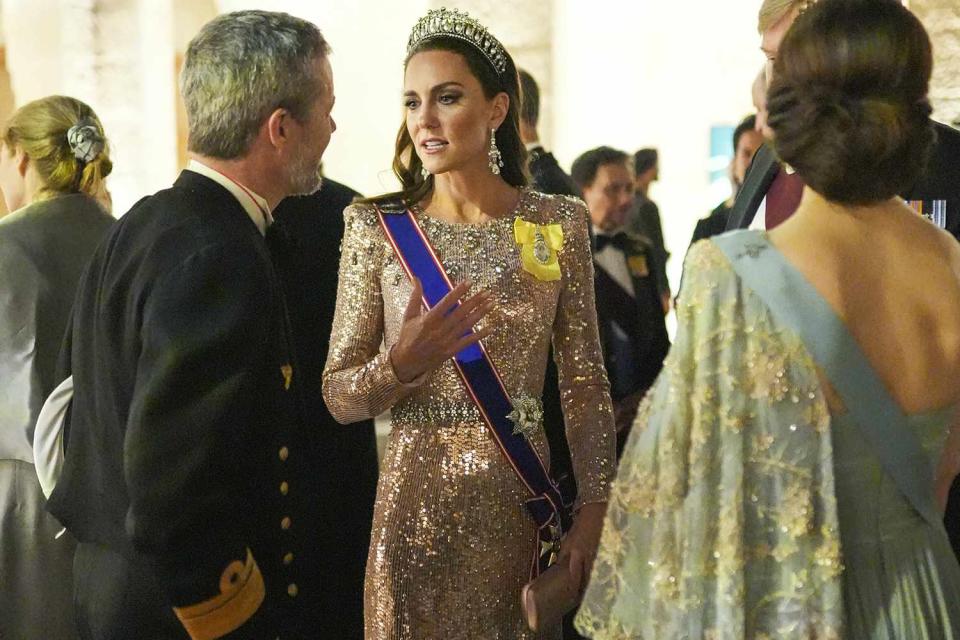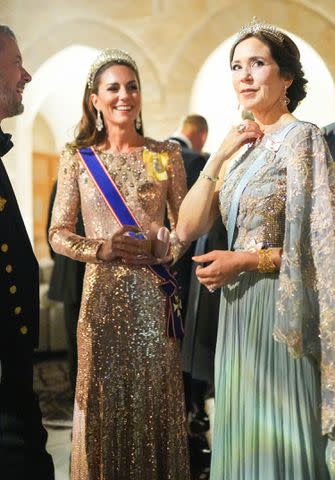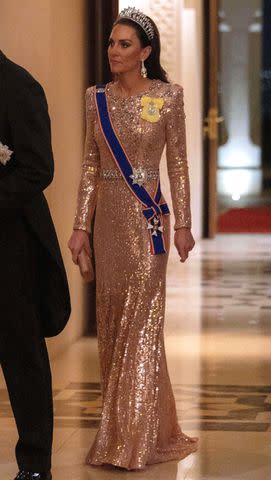Why Kate Middleton's Royal Wedding Tiara Moment in Jordan Marked a New Milestone for the Princess
The Princess of Wales chose her go-to headpiece, Queen Mary's Lover's Knot tiara, but it was still a royal first

Royal Hashemite Court / DPA Picture Alliance / Avalon
Kate Middleton just had a royal tiara first!
The Princess of Wales, 41, glittered at the evening banquet following Crown Prince Hussein and Princess Rajwa of Jordan's royal wedding on Thursday. For the event, Princess Kate opted to sport one of her go-to royal headpieces: the diamond and pearl Queen Mary’s Lover’s Knot tiara. Although she's worn the tiara on multiple occasions before, the glamorous moment marked the first time Kate has ever worn a tiara outside of the U.K.
Kate also wore the Queen Mary's Lover's Knot differently than usual, making for a personal style first. While she typically wears her hair in an elegant updo for formal occasions calling for the royal head-toppers, the Princess opted to wear her hair down at the wedding banquet with the tiara doubling as a headband.
Princess Kate first experimented with the tiara and loose hair combination in December at the Diplomatic Corps reception at Buckingham Palace. However, for that outing, she sported the Lotus Flower tiara (wearing the headpiece for the first time since 2015!).
RELATED: Every Time Kate Middleton Has Worn a Tiara — See the Photos!

Alamy Live News
The Princess of Wales has worn one other tiara: on her wedding day in April 2011, she slipped on Queen Elizabeth's Cartier Halo tiara paired with a half-updo with loose curls.
Her next tiara wear would be a year and a half later when she wore the Lotus Flower to a palace reception with her tresses arranged similarly. The royal then shifted to chignons, which would dominate as her go-to tiara hairstyle for the next seven years.
According to the Court Jeweller, Queen Mary's Lover's Knot tiara — which features pearls hanging from diamond knots — is more than a century old and was originally commissioned from jeweler Garrard by Queen Mary in 1913 or 1914. The piece is a replica of a tiara owned by Queen Mary's grandmother, Princess Augusta of Hesse, who was titled the Duchess of Cambridge (just like the current Princess of Wales).
Princess Kate most recently wore the tiara in December for the South Africa state visit to the U.K. — her first time wearing such a royal headpiece in nearly three years, partially due to the COVID-19 pandemic.

Abaca Press/Alamy Live News
In another fashion first, Princess Kate accessorized her tiara and Jenny Packham gown on Thursday with her debut in the Greville Chandelier earrings.
The stunning jewels were a tribute to the late Queen Elizabeth, who received the earrings as a wedding present from her parents King George VI and Queen Elizabeth, the Queen Mother when she married Prince Philip in 1947, according to the Royal Collection Trust.
Can't get enough of PEOPLE's Royals coverage? Sign up for our free Royals newsletter to get the latest updates on Kate Middleton, Meghan Markle and more!
Princess Kate wasn't the only royal woman sporting a tiara first at Crown Prince Hussein and Princess Rajwa's royal wedding. In addition to the bride sporting her first tiara for the ceremony as well as the following reception and banquet (worn with a second wedding dress), Princess Beatrice wore her mother Sarah Ferguson's York tiara for the first time. The headpiece was bought by Queen Elizabeth for Fergie, as the Duchess of York is affectionately known, and worn at her 1986 wedding to the Queen's son Prince Andrew.
Princess Beatrice, 34, made her tiara debut at her July 2020 wedding, donning the Queen Mary diamond fringe tiara, just like her grandmother Queen Elizabeth wore at her own nuptials.
For more People news, make sure to sign up for our newsletter!
Read the original article on People.

 Yahoo Sports
Yahoo Sports 